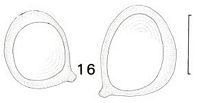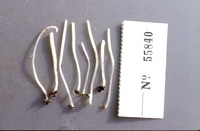|
 Clavaria acuta Clavaria acuta
BiostatusOccurrence uncertain
Images (click to enlarge)
Caption: Fig. 16 Clavaria cf. acuta. spores, TENN no. 43604. Scale bar = 5µm. | 
Caption: as Clavaria cf acuta |
Article: Petersen, R.H. (1988). The clavarioid fungi of New Zealand. New Zealand Department of Scientific and Industrial Research, Bulletin 236: 170 pp. Wellington:.
Description: Fruit bodies up to 50 x 3 mm, simple clubs, scattered to gregarious but not cespitose, arising
from a small white mycelial patch, white to very pale ivory ("pale olive-buff", "cartridge-buff") all over.
Stipe up to 2 mm thick, appearing silky-shining. Club equal, terete, appearing
somewhat waxy. Odour and taste negligible.
Tramal hyphae of club 4-12 nm diam., hyaline, unclamped, thin-walled, strictly parallel,
involving abundant crystalline material, occasionally secondarily septate. Subhymenium
extensive, subpseudoparenchymatous. Hymenium thickening; basidia 40-45 x 7.5-9 µm,
clavate, clamped or bifurcate basally; contents multiguttulate to granular at maturity;
sterigmata 4, slender, curved-ascending.
Spores 6.1-7.6x5.4-6.5 µm (E = 1.13-1.40; Em = 1.20; Lm = 6.91 µm), subglobose to broadly
ellipsoid, hyaline, thin-walled, smooth; contents uniguttulate; hilar appendix small, papillate.
Notes: There are no discernible differences between the specimens listed in "Specimens Examined"
and the common concept of C. acuta, and because C. acuta has been reported from Australia
(Petersen 1979) and Tierra del Fuego (Petersen 1985, unpublished data), I am willing to use
this name here.
The only difference between this and C. redoleo-alii is the odour and taste of garlic of the
latter. C. acuta differs from C. echino-brevispora in having smooth spores, and lacking
yellow pigment in the fruit bodies.
|